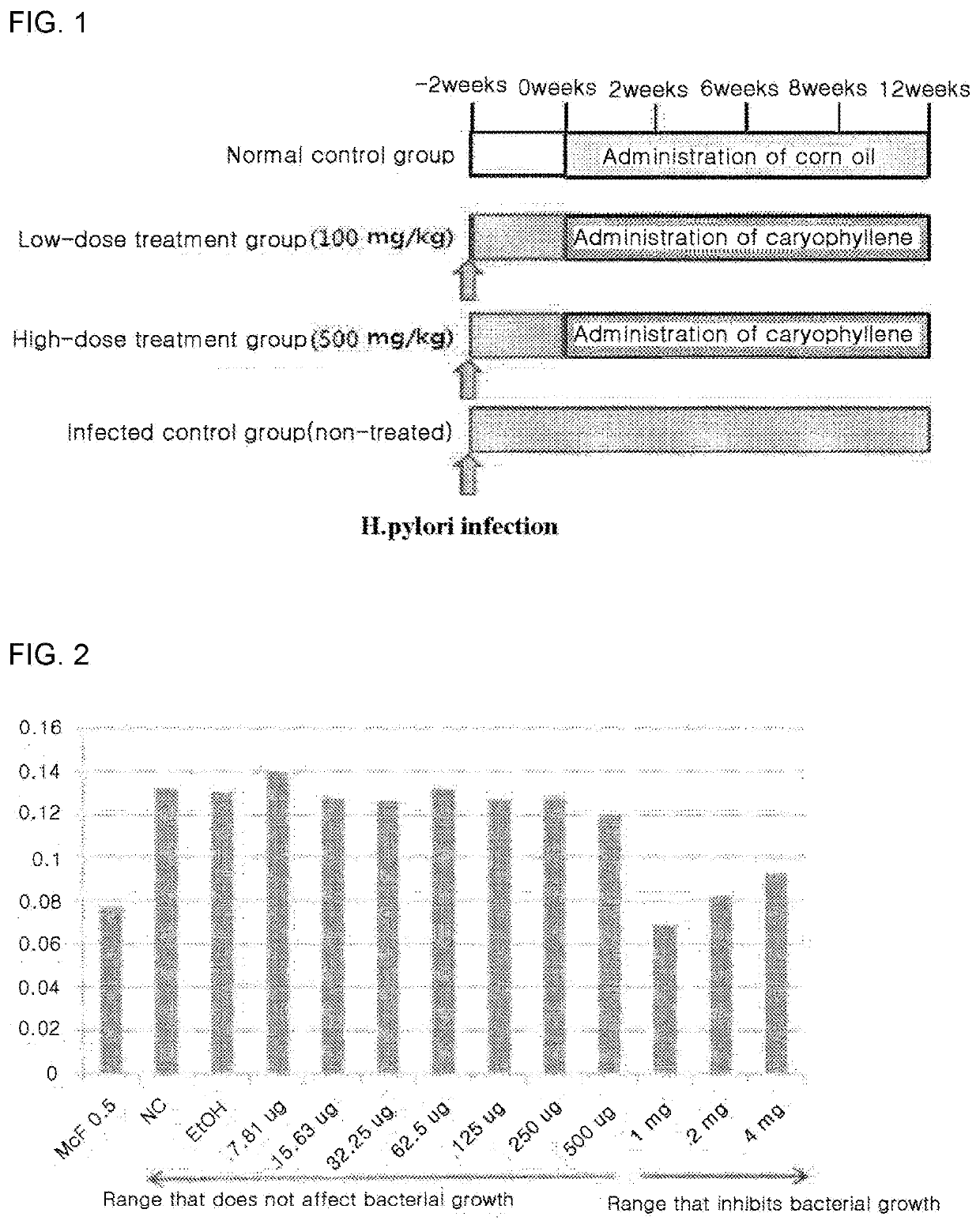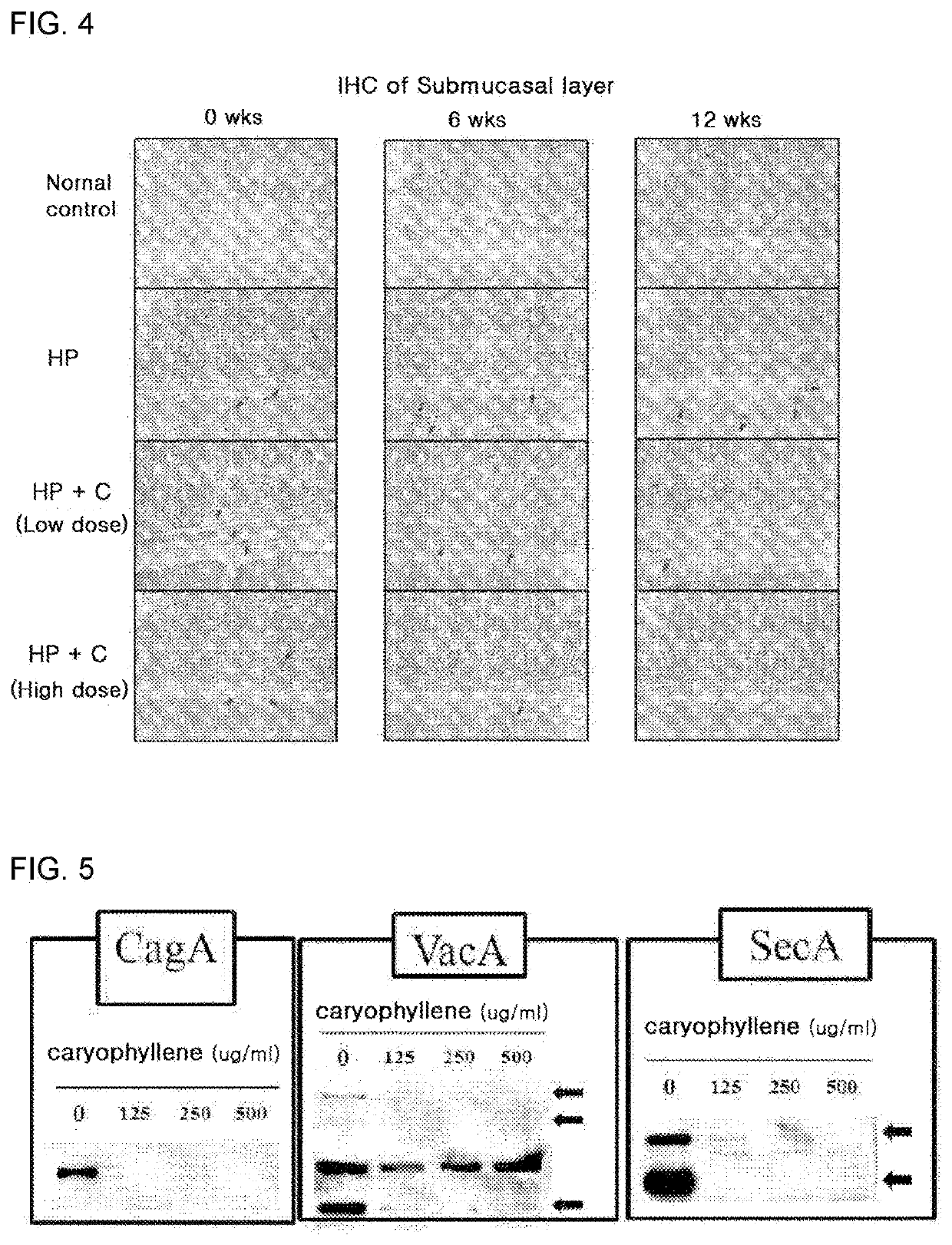Anti-helicobacter food composition comprising beta-caryophyllene
- Summary
- Abstract
- Description
- Claims
- Application Information
AI Technical Summary
Benefits of technology
Problems solved by technology
Method used
Image
Examples
experimental example 1
i
[0028]For H. pylori culture, an H. pylori (ATCC 49503) strain was inoculated on a Brucella agar medium containing 10% bovine serum and antibiotics (vancomycin, esfsuldin, trimethoprim, and amphotericin B), and cultured in an anaerobic incubator which maintains 10% CO2, 5% O2, 85% N2, and 97% or more humidity, at 37° C. for 72 hours.
experimental example 2
Infected with H. pylori
[0029]Mongolian gerbils were infected with a Helicobacter pylori strain (ATCC 49503) and then subjected to two weeks of acclimatization. To this end, the animals were fasted for 12 hours before and after inoculation with the Helicobacter pylori strain. 500 μl (1×109 CFU) of a bacterial suspension was prepared by suspending H. pylori in sterile physiological saline to a concentration of 2×109 CFU / ml and introduced directly into the stomach by using a feeding needle. For stable infection, the H. pylori strain was dispensed three times at 48 hour-intervals.
[0030]As shown in FIG. 1, the experimental animals were divided into four groups: non-infected group (NC) (not infected with H. pylori), infected group (HP) (infected with H. pylori), low-dose group (treated with 100 mg / kg of beta-caryophyllene), and high-dose group (treated with 500 mg / kg of beta-caryophyllene). Beta-caryophyllene was administered directly into the gastrointestinal at doses of 100 mg / kg and 5...
experimental example 4
on Effect Between Beta-Caryophyllene and Antibiotics that are Used for Treatment of Helicobacter pylori Infection
[0065]In order to compare the Helicobacter pylori eradiation effect between beta-caryophyllene and the antibiotics that are used for treatment of Helicobacter pylori infection, an animal test was performed using the test groups and doses shown in Table 1 below.
[0066]Each test substance was suspended in an excipient according to the dose and administered to each mouse once a day at the same time every day for a total of 28 days in a dose of 5 ml per kg mouse (C57BL / 6 mouse) by oral gavage method.
TABLE 1GroupInfectionSampleDose (ml / kg)G1PBSCorn oil5G2PBS0.5% CMC5G3H. pyloriCorn oil5G4H. pylori0.5% CMC5G5H. pyloriMTN + CLR + PPI5G6H. pylori100 mg / kg5G7H. pylori200 mg / kg5G8H. pylori500 mg / kg5G1: Non-infection, corn oil,G2: Non-infection,G3: infection,G4: infection,G5: MTN (14.2 mg / kg / day),CLR (7.15 mg / kg / day),PPI (138 mg / kg / day),G6: 100 mg / kg / day,G7: 200 mg / kg / day, andG8: 500...
PUM
| Property | Measurement | Unit |
|---|---|---|
| Temperature | aaaaa | aaaaa |
| Fraction | aaaaa | aaaaa |
| Mass | aaaaa | aaaaa |
Abstract
Description
Claims
Application Information
 Login to View More
Login to View More - R&D
- Intellectual Property
- Life Sciences
- Materials
- Tech Scout
- Unparalleled Data Quality
- Higher Quality Content
- 60% Fewer Hallucinations
Browse by: Latest US Patents, China's latest patents, Technical Efficacy Thesaurus, Application Domain, Technology Topic, Popular Technical Reports.
© 2025 PatSnap. All rights reserved.Legal|Privacy policy|Modern Slavery Act Transparency Statement|Sitemap|About US| Contact US: help@patsnap.com



